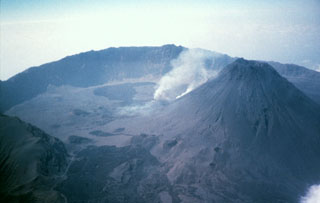Report on Fogo (Cabo Verde) — 31 December-6 January 2015
Smithsonian Institution / US Geological Survey
Weekly Volcanic Activity Report, 31 December-6 January 2015
Managing Editor: Sally Sennert.
Please cite this report as:
Global Volcanism Program, 2014. Report on Fogo (Cabo Verde) (Sennert, S, ed.). Weekly Volcanic Activity Report, 31 December-6 January 2015. Smithsonian Institution and US Geological Survey.
Fogo
Cabo Verde
14.95°N, 24.35°W; summit elev. 2829 m
All times are local (unless otherwise noted)
Based on gas-monitoring efforts of the Instituto Vulcanológico de Canárias (INVOLCAN) and data from the Toulouse VAAC, the Observatório Vulcanológico de Cabo Verde (OVCV) reported that sulfur dioxide emission rates at Fogo were 1,201-1,368 tons per day during 30-31 December and 1-2 January. A gas plume rose 700-900 m above the cone during 30-31 December and drifted N; on 31 December tephra was ejected 30-40 m away and ash was present on the plume. A lava front near S Ilhéu de Losna had been stagnant for a few days while one near the N part of the town advanced at a reduced speed, overtaking a road and parts of some housing. Temperatures of the lava fronts continued to gradually decrease. During 1-2 January a gas plume rose 400-600 m above the cone and tephra was occasionally ejected 20-25 m away.
Geological Summary. The island of Fogo consists of a single massive stratovolcano that is the most prominent of the Cape Verde Islands. The roughly circular 25-km-wide island is truncated by a large 9-km-wide caldera that is breached to the east and has a headwall 1 km high. The caldera is located asymmetrically NE of the center of the island and was formed as a result of massive lateral collapse of the older Monte Armarelo edifice. A very youthful steep-sided central cone, Pico, rises more than 1 km above the caldera floor to about 100 m above the rim. Pico, which is capped by a 500-m-wide, 150-m-deep summit crater, was apparently in almost continuous activity from the time of Portuguese settlement in 1500 CE until around 1760. Later lava flows, some from vents on the caldera floor, reached the eastern coast below the breached caldera.
Source: Universidade of Cabo Verde

